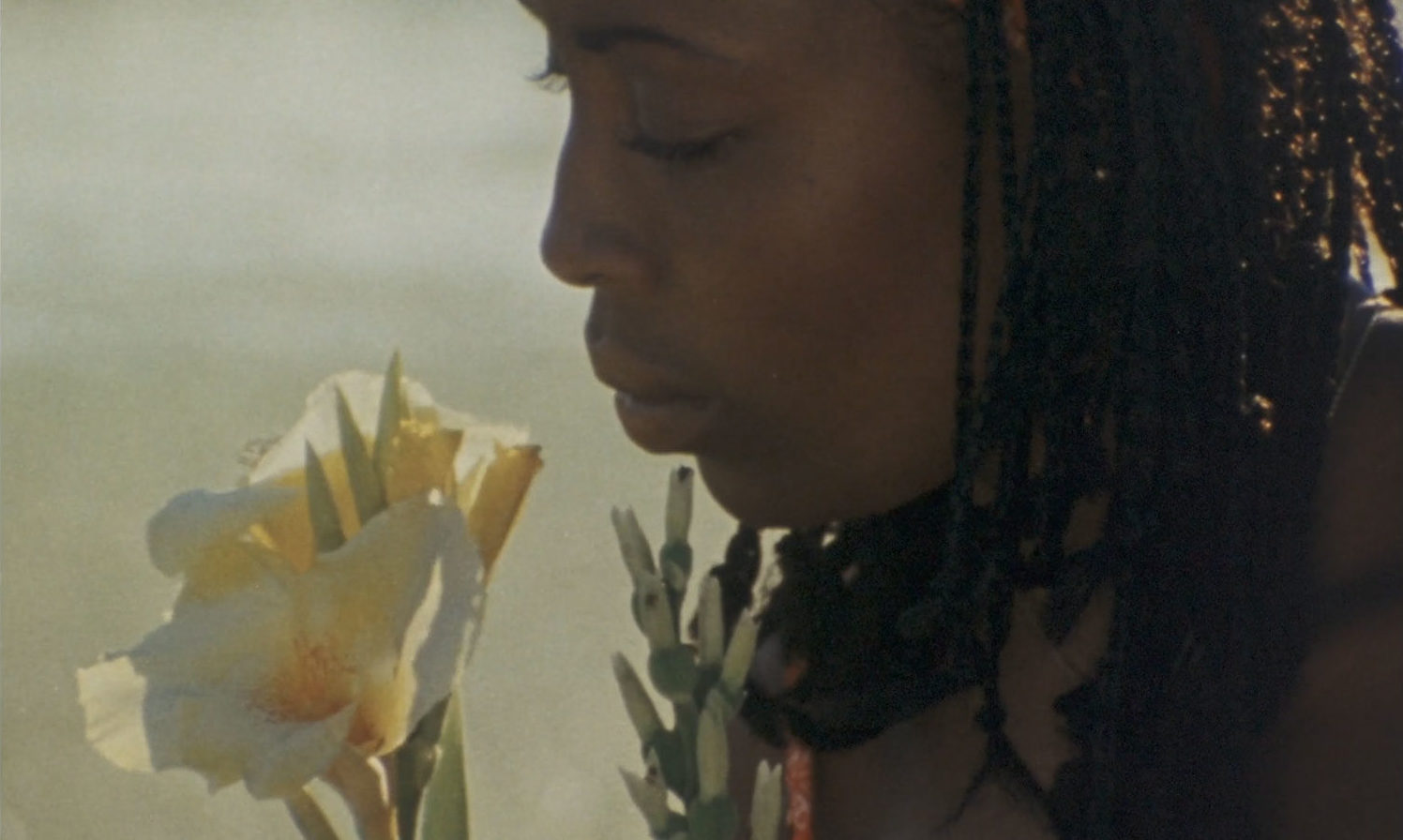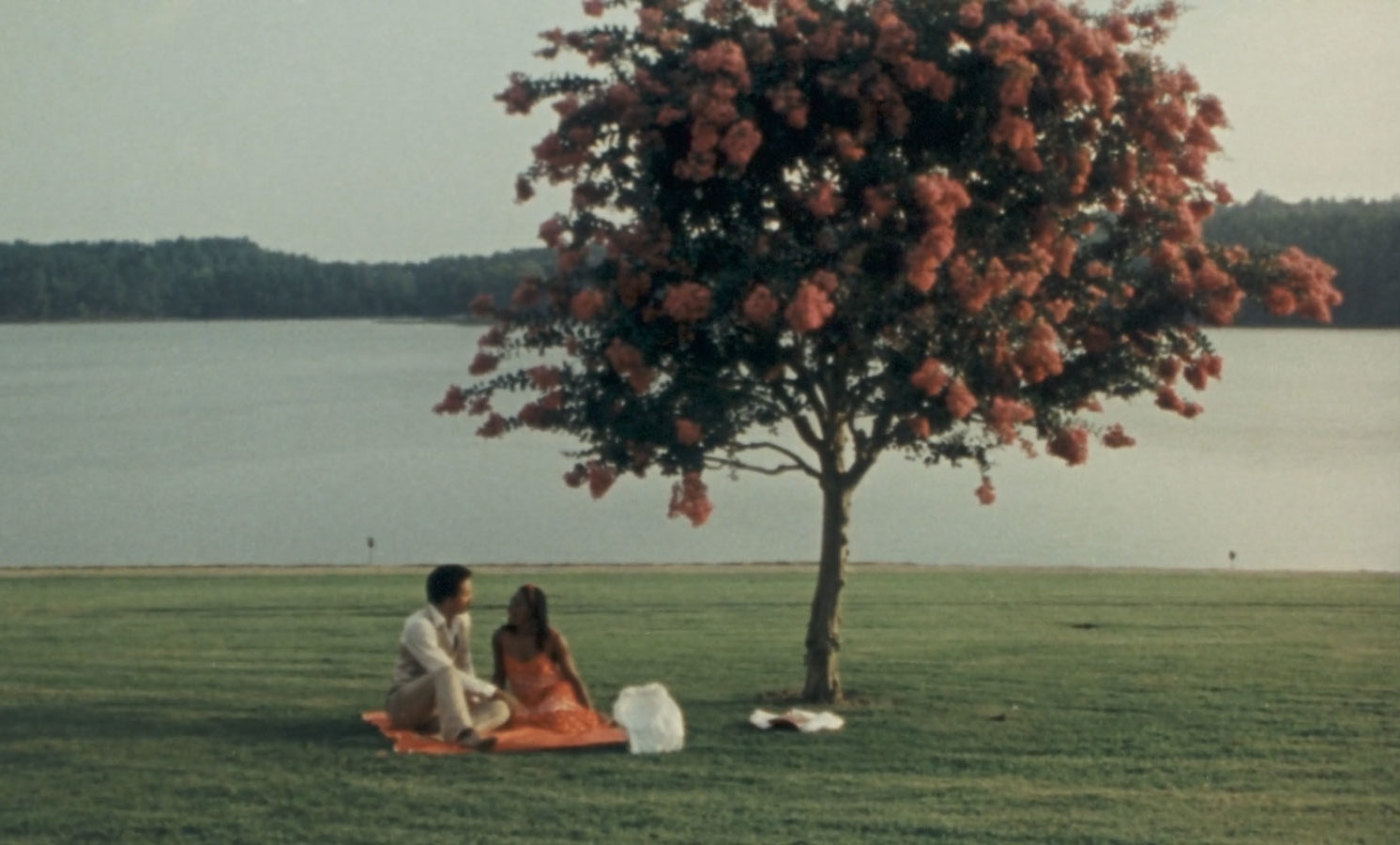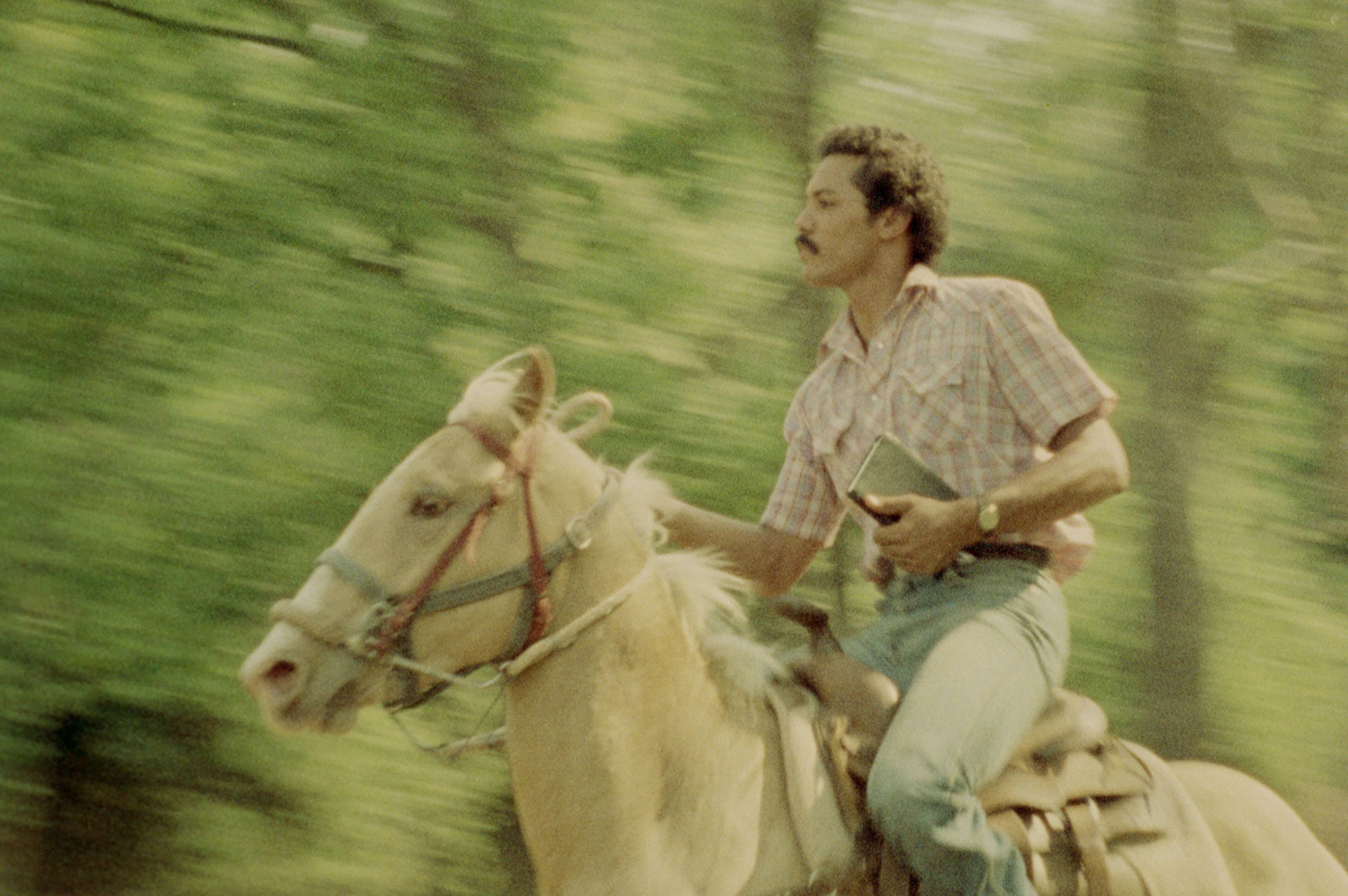Two black households, not alike in dignity, in fair Louisiana, where we lay our scene: the Metoyers, “high yellow” Catholics, propertied Creoles with a good-looking son; and the Mathises, darker-skinned, poor, Baptist churchgoers with an equally good-looking daughter. Boy meets girl and they fall in love, but not without the intrusion of entanglements that have come before them.
The newly restored film Cane River, directed by Horace B. Jenkins and first released in 1982, is not a typical Shakespearean story of forbidden love because it makes visible the ways in which the transatlantic slave trade is still with us, hanging over even intimate relationships. The plot follows the ups and downs of a conventional romance’s plot of courtship, but the major conflict is hushed—no dramatic upsets, just the slow but powerful tick of history.
Peter Metoyer (played by Richard Romain) is a young man who abandons his professional football career to move back to his hometown in rural northwest Louisiana’s Natchitoches Parish. Feeling like “a commodity,” he’s returned to the quiet Cane River community to work on his family’s farm and write poetry. Maria Mathis (Tommye Myrick) works as a tour guide at the former plantation where Metoyer’s ancestors lived, saving up with the hopes of leaving home to study at Xavier University in nearby New Orleans.
Five years after high school, she is still caught up in her hectic home life. Her stifling mother and overbearing brother oppose her relationship with Peter, her brother cautioning her: “Them Metoyers don’t have no need, no use for no folks like us. They ain’t a kin to us. They say they special, call theyself the people. And not only that, they enslaved us, girl!” Maria’s mother’s objection is more pragmatic as she doesn’t want her daughter’s college plans to be thwarted: “He’s a Creole. You are nothing to him. You’re something for him to use, don’t you understand?” These familiar cautions are double-edged: Maria is rendered vulnerable both by her gender on the one hand and by her racialized class status on the other.
She, of course, has her own plan. “I gotta make something of myself and I can’t do that in Natchitoches,” Maria says to Peter when he says he’s in love, wants her to marry him and forfeit college in New Orleans. “I’m never gonna depend on some man, Peter. I’m not gonna be like mama.” Maria knows from familial experience that typically men leave and women wait. Even her father, who died some years ago, is accused of abandonment. This time, Maria, aspiring to self-sufficiency, wants to be the leaver, to defy the fate of confinement. Will she go away for school, or will she stay to be with Peter?
*
In a 1981 interview with Sharon-Elizabeth Sexton for the television program Folks, the writer, director, and producer Jenkins said that Cane River, his only feature film, is “basically a story about values and about people that are headed in two different directions… When [Peter] reached Cane River, he was happy to be there and he met a young lady who was headed in the other direction.” This emphasis on directionality—where we head and why—is crucial, not least because the film reminds us that movement for black people is so often inhibited, by borders, families, memories, laws, norms.
But there are other things, Cane River shows us, that remind us of freedom and of vitality under conditions of unfreedom: clouds reminiscent of birthday cakes, roads overgrown by grass, the chirping of the birds carried on the balmy air, the infinite, generous demand of nature. With the rotund cinematography of Gideon Manasseh, the opening minutes of Cane River alone move through several scenes of the outdoors, a rainbow of synesthetic greens: a baseball game, Peter swimming with friends in a secluded bayou, a sun setting behind a bush, Peter walking in the woods, Peter on a horse, Peter on a bus watching the Louisiana plains go by, Peter sitting in the shade writing poetry.
The film was shot with an all-black cast and crew, primarily in Natchitoches, with a jaunt in New Orleans. Cane River revels in what the scholar Hortense Spillers calls “intramural black life”—that is to say, those relations between and among ourselves. These complexities within a community have more components, conflicts, vagaries, and intricacies than ever typically appear on the screen, either when the film was made or now. This is particularly important because Cane River rubs up against what the writer and academic Frank B. Wilderson III calls the “pedagogic value” of black American cinema, carving out a space beyond tired preoccupations with the cinematic representations of Hollywood.
Advertisement
In other words, this movie has everything to do with land’s relationship to territory and property but it also, more specifically, has to do with what some have called the “black outdoors,” a concept that sits in a kind of paradox. Where black people live within the constraints of forced enclosure, they also have a knowledge of what it might mean to live outside of the bounds of citizenship and the state. Like the concept of the “black outdoors,” Cane River presents nature as more generative than mere land ownership—from which black people have been historically excluded—offering ethical ways to relate to ecology, to feel its unevenness. Cane River doesn’t go as far as some contemporary black thinkers might toward advocating the abolition of property, but its metropolitan audience, renters, can dream.
The poster for Cane River, which I saw in the cold days of February as a cardboard cutout propped up in the lobby of the Brooklyn Academy of Music, features Peter riding Western-style on a light auburn horse, a book in one hand and reigns in the other, the forest blurring beyond him. This particular shot, with its bucolic color palette, reflects the meditative aesthetics of the entire film. This is not Baz Luhrmann’s 1996 adaptation Romeo + Juliet—with its psychedelic dystopia and doomed romanticism—but an agrarian pastoral of blues and oranges and blacks. It is where things bloom. It is the steadfast pursuit of beauty.
By grounding its setting in the black South as a beautiful place scarred by a terrible history of slavery that perpetually surfaces in the present, the film refuses a hermetic seal between a romance movie and a “socially engaged film.” Running through the chemistry of these beautiful, stylish personalities—Peter with his handlebar mustache and Maria with her headband and floral button-up—is intellectual banter that reverberates with concerns of epic import: What makes a poet? How does prejudice work? Aren’t black athletes made into commodities through capitalism? And isn’t football brutal? Together, the two principal characters become fixated on ideas—not as abstractions but as material facts that impact their lives.
The most weighty topic of their conversations is about historical responsibility, and takes place at the slave estate-turned-museum, where Maria works and Peter’s ancestors lived. The couple meets at Melrose where, two hundred years prior, Peter’s great-grandmother, “an African woman who owned slaves,” became embroiled with the slave market. The Metoyers collaborated with the Confederate Army, she says. “Hey, we were proud of Jackie Robinson,” Peter retorts, as if his love for exceptional black people absolves him and his family of complicity. “Big deal, Peter,” Maria says.
Peter and Maria don’t know how or when or if they should reckon with what happened in the past. Through their shared attempt at reckoning, however, Cane River offers a prescient perspective on how history lingers, and how blackness is not simply diverse in a neoliberal multiculturalist sense, but also contradictory and in conflict politically, thanks in part here to the caste system consolidated by the Louisiana Purchase in 1803. “I know there are calls for black unity,” Angela Davis said recently, about today’s uprisings. “I would prefer to say black radical unity—I would prefer some other adjective there because there are black people I definitely do not want to unify with.”
*
Horace B. Jenkins died of a heart attack at the age of forty-two late in 1982, just after the film’s New Orleans premiere but before it premiered in New York the following year. The comedian Richard Pryor was an early fan and wanted to bring the movie to Hollywood, but the executive producers, a wealthy black family, declined, an example of the structural obstacles for black film in a white-run industry. Jenkins got sick shortly after the producers’ decision. In other words, the movie was released just after the death of its author, a career aborted by what the writer and scholar Saidiya Hartman would call “skewed life chances.” Without the advocacy of its maker, at a time when independent backing outside white institutions was not guaranteed, Cane River disappeared from view.
The film entered circulation somewhere between the blaxploitation movies of the 1970s, the indie contemporaries of the LA Rebellion film movement, Kathleen Collins’s semi-autobiographical 1982 film Losing Ground, the Spike Lee status quo, and the 1997 release of Eve’s Bayou, Kasi Lemmon’s representation of a Louisiana Creole family. Lost even to the black film canon for thirty years, the negative of Cane River was discovered at the archives of New York City’s DuArt Film and Video only in 2013.
Advertisement
Jenkins was educated in film at the Sorbonne and won multiple Emmy awards for his production work. As a filmmaker in his own right, he was primarily a documentarian; in 1978, he won the Oscar Micheaux Award for best documentary and best film for Sudan’s Pyramids: Azandi’s Dream, an hour-long public television production about the ancient Kushite kingdom. Why does a cosmopolitan man get entranced with a small community like Cane River where, as one character says, “Ain’t nothin’ happenin’ ’round here”? Given that the film was inspired by the hometown of Jenkins’s partner, Carol Balthazar, who also served as story consultant, it’s difficult not to wonder to what extent the screenplay was autobiographical. Many are surprised Peter is happy to return: “You done been halfway around the world and you’re talking about you glad to be back here,” as one of his friends, a horse trainer, says. Why do we want to go back to where we come from, especially when it’s a nowhere, a place no one has ever heard of? Moreover, what does it mean, from a black feminist perspective, that Peter wants to settle down and get married at the same time Maria dreams for escape?
Despite their family’s differences, it is clear that Peter and Maria share a charming sense of peace from communing with nature—it is one of their primary ways of connecting with each other. And yet the world-historical as it already exists easily bleeds into the romance of two individuals, even while one dreams of a black radical feminist future. Driving down the highway with Peter, Maria’s arm catches the Louisiana breeze and, at the film’s climax, she plainly identifies her quest, one not completely compatible with Peter’s: “Free-dom, free-dom, free-dom,” she says, lacing each syllable with fire. They might both say “freedom,” but they mean different things. With Peter, she feels expansive but, poking fun at herself, quickly turns to a sing-songy spiritual, quoted in Martin Luther King Jr.’s most famous speech: “Free at last! Free at last! Thank God almighty I am free at last,” laughing even more.
Her own claim to such freedom—to move, to go to school, to feel the sun’s heat—connects with past struggles for liberty. Peter, ennobled by ignorance, declares he hasn’t even heard of the quotation. Put another way, while their varied experiences of blackness—woman and man, propertied and unpropertied, Baptist and Catholic, light and dark—may be offset by romantic love, even the iconic “I Have a Dream,” speech cannot offer them a shared sense of freedom.
Cane River is now streaming on Criterion Channel, free through June.





